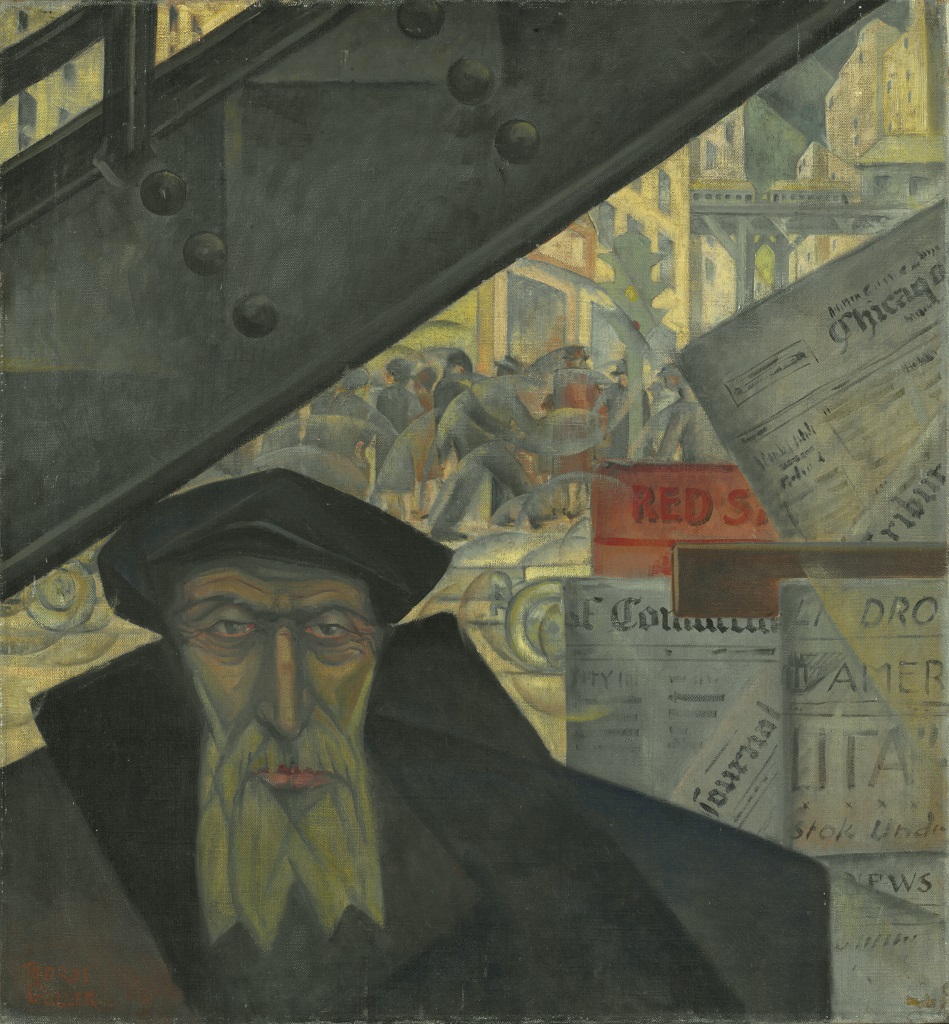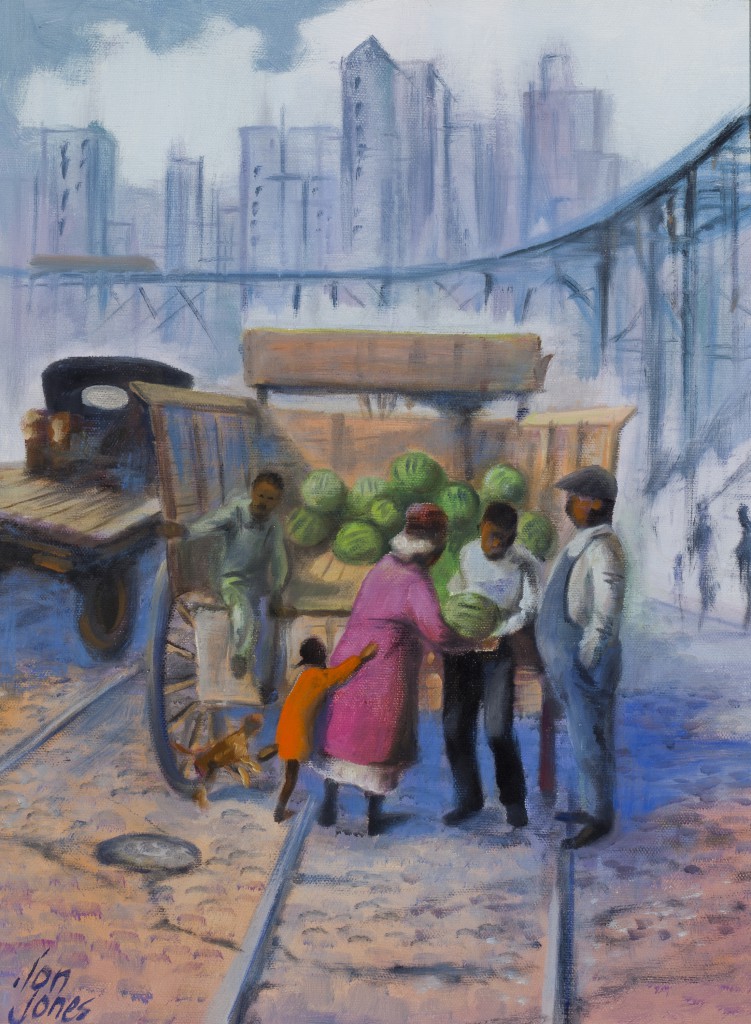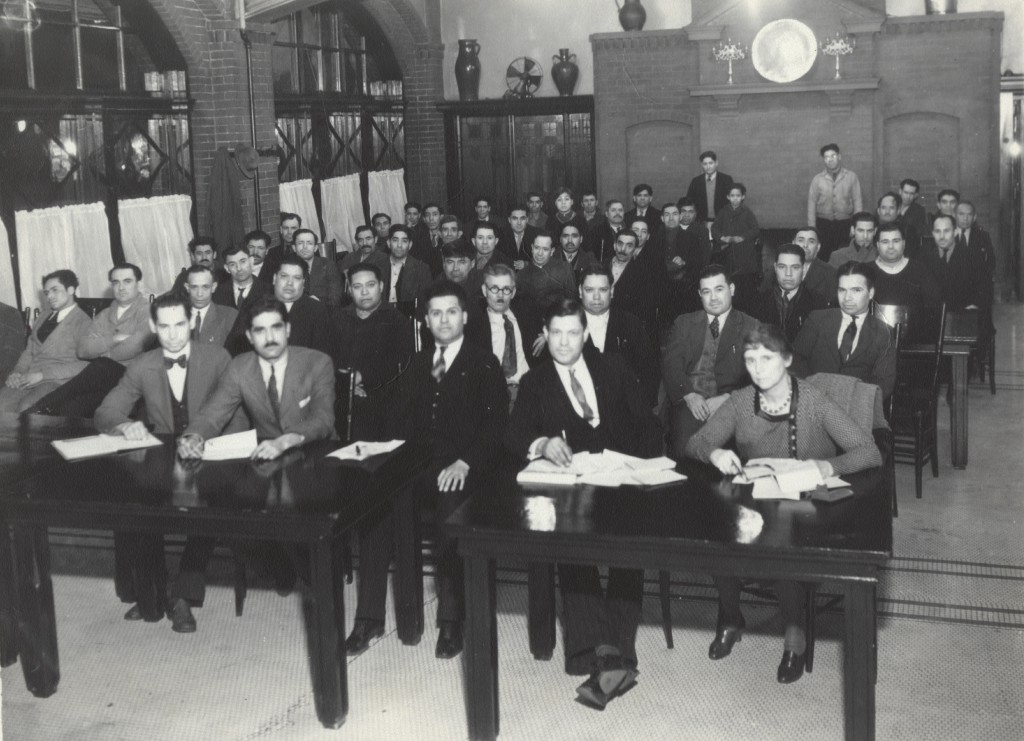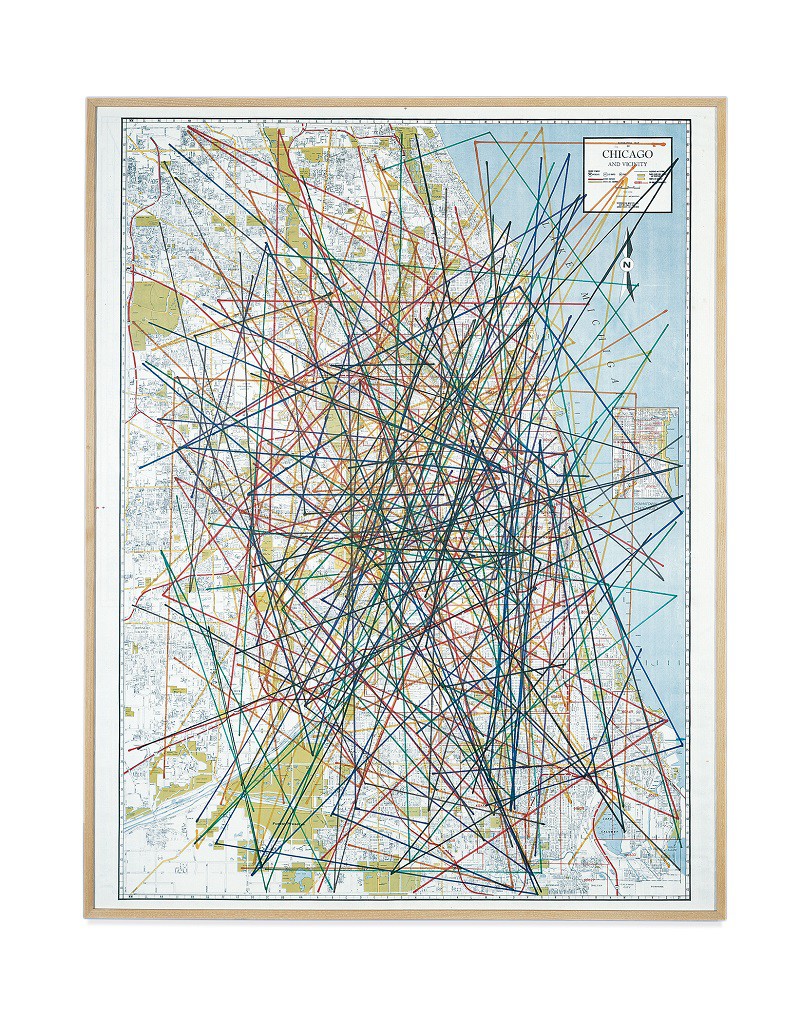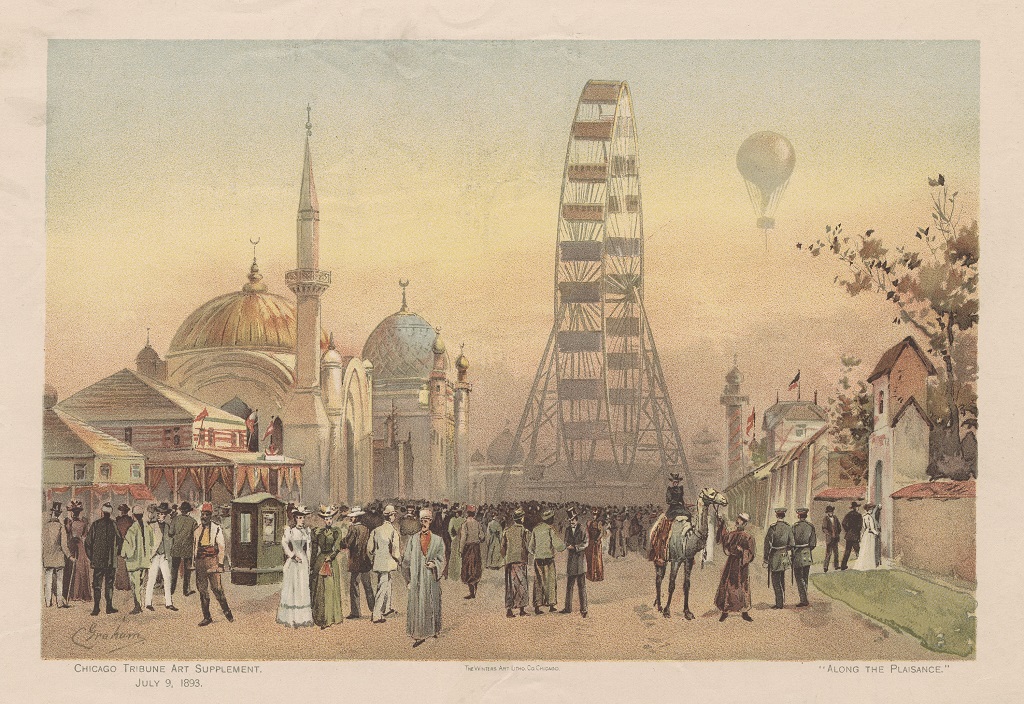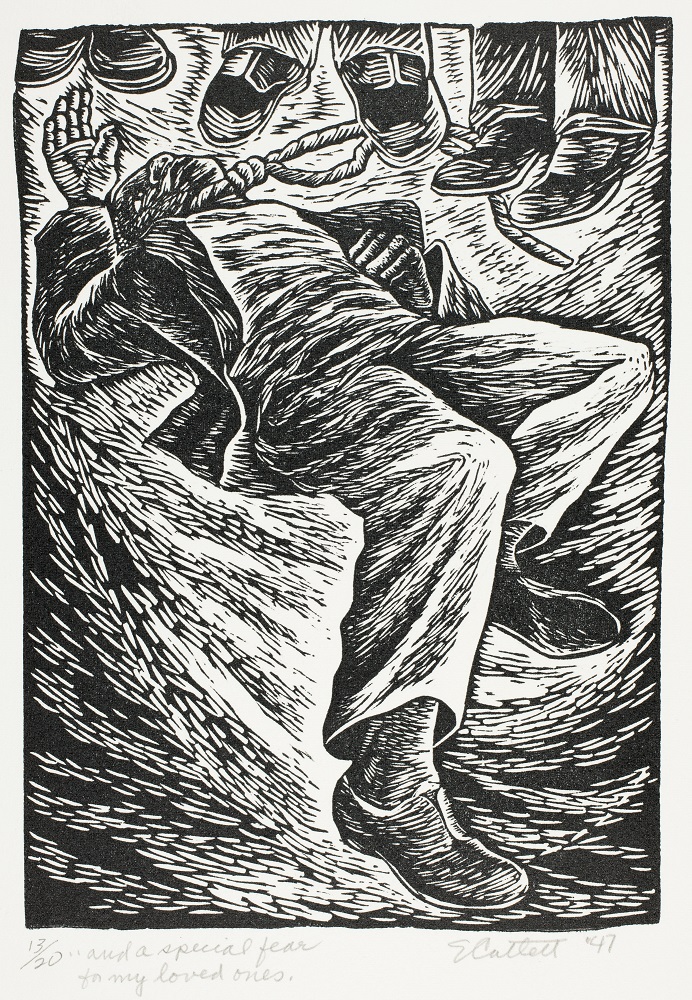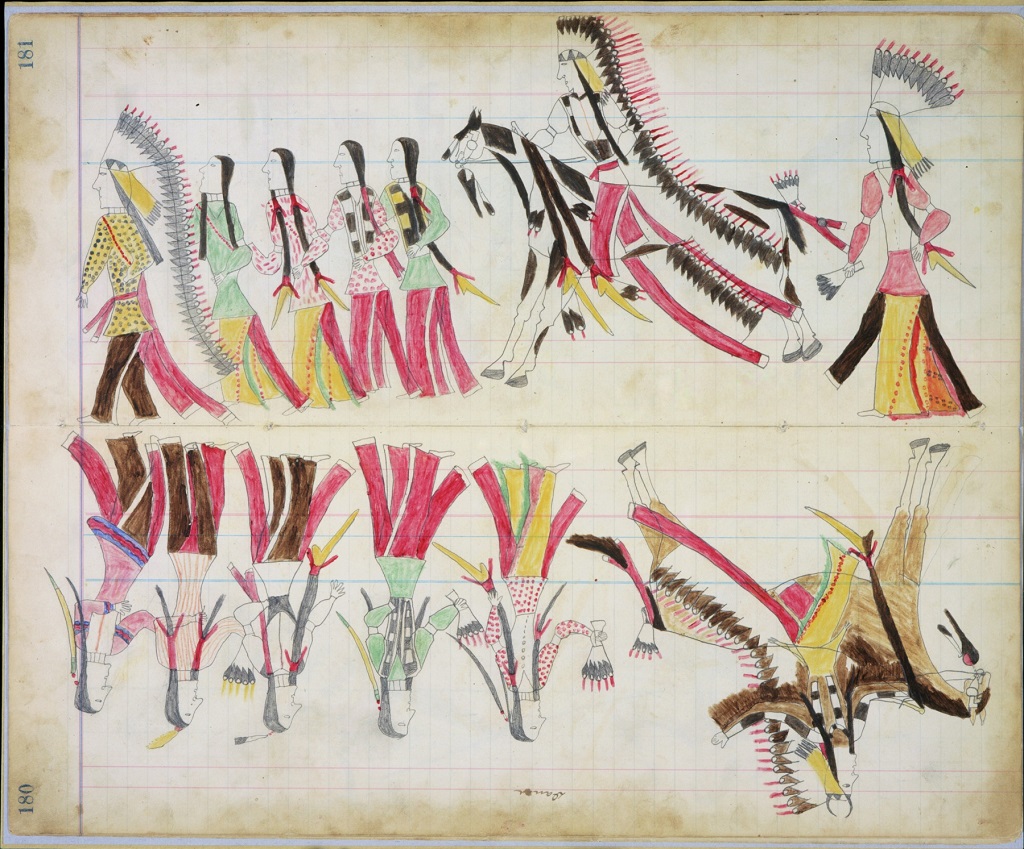Author:
Nevada Montgomery, The DuSable Museum of African American History
Summary:
People who migrated or immigrated to Chicago in the late 1800s and early 1900s encountered many challenges and opportunities. Through the artwork and primary sources presented in this lesson, students will analyze how these newcomers adapted to their new environments and went through a process of assimilation that had both costs and benefits. To conclude the lesson, students will create a layered collage that depicts the processes of adaptation and/or assimilation.
Lesson Overview
Grade Levels: 9–11
Time Needed: 4–5 class periods, 40–50 minutes each
Background Needed
Students should have experience with closely analyzing a work of art. The following lesson provides a useful introduction:
The following video provides a teaching model for a deep analysis of Todros Geller’s Strange Worlds, a painting that is referenced in this lesson: https://www.youtube.com/watch?v=_5FL0MV3Sso&feature=youtu.be
Essential Questions
- In what ways do individuals and groups adapt when they move to a new home?
- In what ways did migrants and immigrants assimilate as they established themselves in Chicago in the late 1800s and early 1900s?
Enduring Understandings
- For migrants and immigrants, the process of adapting to life in a new place is affected by their interactions with the dominant culture, as well as how they perceive and are perceived by the dominant culture.
- The process of assimilation had both costs and benefits for migrants and immigrants who arrived in Chicago in the late 1800s and early 1900s.
Objectives
- Students will read closely to determine what a text says explicitly and to make logical inferences from it.
- Students will integrate and evaluate content presented in diverse formats and media, including visually as well as in words.
- Students will draw evidence from literary and informational texts to support analysis, reflection, and research.
- Students will prepare for and participate effectively in a range of conversations and collaborations with diverse partners, building on others’ ideas and expressing their own clearly and persuasively.
Key Vocabulary
- adaptation
- assimilation
- citizenship
- the Great Migration
- immigrant
- migrant
- naturalization
- vendor
Standards Connections
Common Core State Standards
Anchor Standards in Reading: http://www.corestandards.org/ELA-Literacy/CCRA/R/
- CCSS-ELA Reading Anchor Standard 1: CCSS.ELA-LITERACY.CCRA.R.1
- CCSS-ELA Reading Anchor Standard 7: ELA-LITERACY.CCRA.R.7
Anchor Standards in Writing: http://www.corestandards.org/ELA-Literacy/CCRA/W/
- CCSS-ELA Writing Anchor Standard 9: CCSS.ELA-LITERACY.CCRA.W.9
Anchor Standards in Speaking and Listening: http://www.corestandards.org/ELA-Literacy/CCRA/SL/
- CCSS-ELA Speaking and Listening Anchor Standard 1: CCSS.ELA-LITERACY.CCRA.SL.1
Materials
In the Classroom
- magazines, newspapers, catalogs, and other sources of images for a collage
- construction paper, glue, scissors, and markers
- a computer with Internet access
- an interactive whiteboard or another classroom projector
Works of Art
- Todros Geller, Strange Worlds
- Jon Jones, Under the El (train)—Selling Watermelons
- Wallace Kirkland, Hull House Coffee Shop, Class on Naturalization, Miss Binford
Other Resources
- Art Study: Strange Worlds, Read to Build Knowledge
- Art Study: Under the El (train)—Selling Watermelons, Read to Build Knowledge
- Close Analysis Questions: Strange Worlds
- Close Analysis Questions: Under the El (train)—Selling Watermelons
- Document Set: Adaptation and Assimilation in Chicago
- Art Study: Hull House Coffee Shop, Class on Naturalization, Miss Binford, Read to Build Knowledge
- Graphic Organizer: Exploring Assimilation through Primary Sources
Lesson Steps
- Discuss the concepts of adaptation and assimilation: Begin by asking students about their experiences with moving to a new neighborhood, town, or even a different school, and about how the move changed them. Introduce the word “adaptation” and ask students to define it (the process of changing in order to adjust to life in a new environment). Invite them to share examples of how they have adapted their behavior to adjust to new situations.
Then introduce the word “assimilation.” Explain that assimilation is the process in which people lose aspects of their home culture as they adopt the ways of the dominant culture. For example, people who move to the U.S. as children sometimes forget their home languages as they learn English. Encourage students to think of other examples of how people may assimilate, such as changing the way they dress, changing the types of food they eat, and letting go of traditions that were practiced in the home country.
Ask students if they can think of some of the positive and negative aspects of adapting and assimilating to a new environment. Record their ideas for further exploration later in the lesson.
- Have students analyze two works of art: Project Todros Geller’s Strange Worlds and Jon Jones’s Under the El (train)—Selling Watermelons.
Divide the class into two groups and assign each group an image. Distribute the following to each student:
- for the Strange Worlds group: a copy of the Art Study: Strange Worlds, Read to Build Knowledge and a copy of the Close Analysis Questions: Strange Worlds
- for the Under the El (train)—Selling Watermelons group: a copy of the Art Study: Under the El (train)—Selling Watermelons, Read to Build Knowledge and a copy of the Close Analysis Questions: Under the El (train)—Selling Watermelons
Have students work with one or two others within their large group to analyze the assigned painting, answer the questions, and read the related informational text. After the groups have completed this task, have each student pair up with someone who analyzed the other painting. Tell them to introduce the artworks to each other, using their responses to the Close Analysis Questions as a guide.
- Compare the paintings in a class discussion: Project both paintings again and use questions like the following to guide the discussion:
- What are the similarities between the watermelon vendors and the newspaper vendor? What are the differences?
- What are some similarities in the colors, shapes, and style that each artist uses? What are some differences?
- Look at the birthdate of each artist and the year that each painting was made. What does this reveal about each painting? (Note: Since Under the El (train)—Selling Watermelons wasn’t painted until 1992, it may portray the artist’s memory of a childhood scene or be an attempt to recreate the long-ago past. Strange Worlds, on the other hand, was painted in 1928 and depicts that time period.)
- What do these images say about how immigrants and migrants to Chicago have adapted or assimilated to their new environments?
- View and discuss a photograph: Project Wallace Kirkland’s photograph, Hull House Coffee Shop, Class on Naturalization, Miss Binford. Use the following questions to guide a discussion:
- When viewing this photo, what do you first notice?
- What details about the room stand out the most? What details about the people stand out the most?
- What inferences can you make about the people who have gathered in this room? What evidence in the photograph supports your inferences?
- Read an informational text about the photograph: Project or distribute copies of the Art Study: Hull House Coffee Shop, Class on Naturalization, Miss Binford, Read to Build Knowledge. Have students work with partners to read the text. As they read, have them note details that help them better understand the photograph and its historical context. Then guide a discussion with questions such as the following:
- What was the purpose of the naturalization class?
- How did Hull-House provide support to immigrants?
- In what ways did Hull-House help immigrants adapt and assimilate to life in Chicago?
- How does the information in the text deepen your understanding of the photograph?
- Conduct primary-source research on assimilation: Tell students that they will now examine three primary-source documents that will deepen their understanding of the costs and benefits of assimilation:
- Document 1.1: “I Discover Hull-House” by Hilda S. Polacheck
- Document 1.2: “Chicago’s Urban League Offers Assistance to Southern Migrants”
- Document 1.3: Excerpt from “How It Feels to Be a Problem…” by Gino C. Speranza
Have students work in groups of two or three. Distribute a copy of the Document Set: Adaptation and Assimilation in Chicago to each group. Note that two of the documents must be accessed online for permissions reasons.
Give each student a copy of the Graphic Organizer: Exploring Assimilation through Primary Sources. Explain that students should work together to read each primary source and respond to the questions on the graphic organizer.
- Discuss the results of the research: Invite the groups to share their responses to the questions, adding onto each other’s ideas. Continue the discussion with questions such as the following:
- In what ways was the Christmas party an experience of assimilation for Hilda Polacheck?
- What were some benefits of that experience of assimilation? What were the costs, if any? (You might point out that she wasn’t able to share her experience with her mother.)
- The Chicago Urban League provided some “self-help” advice to recently arrived migrants. In what way was this advice a form of assimilation?
- What does the Urban League’s advice reveal about how African Americans were expected to assimilate? What are some costs and benefits of this?
- Why does Gino Speranza believe that he is considered to be “a problem”? How does he feel about that?
- What does he believe is necessary for assimilation to occur?
- When immigrants and migrants assimilate to a new environment, what do they lose?
- From the sources you’ve looked at, how voluntary do you think assimilation was for immigrants or migrants?
Revisit students’ ideas about the positive and negative aspects of adaptation and assimilation that were recorded in step 1. Invite them to add new ideas that they’ve learned through further research and analysis.
- Have students create a collage: Tell students that they will draw upon what they have learned from the sources used in this lesson to create a visual representation of how immigrants or migrants adapted and assimilated to their new life in Chicago in the early twentieth century. Have them invent a character who is represented by one or more of the sources, such as:
- a character from one of the paintings
- someone who receives advice from the Chicago Urban League
- a child who meets other immigrant children at Hull-House
- an immigrant or migrant who objects to being considered a “problem”
Explain that students will create a layered collage for the character they have chosen. For each layer, they should draw upon images and quotations from this lesson as well as adding images and text from newspapers, magazines, and other sources. The layers can be set up as follows:
- 1st layer: Include words and images that represent the character’s original home.
- 2nd layer: Include words and images that represent the character’s new home in Chicago. Show items that represent how the person had to change in order to fit in.
- 3rd layer: Include words and images that show what the person kept from his or her home culture and what was added from his or her new place.
Students should give the collage a title that includes the name of their character. They should also write a short piece that explains why the person came to Chicago, describes the items in each layer of the collage, and reflects on how much this individual has adapted or assimilated to the new environment.
Additional Resources
Arredondo, Gabriela F. Mexican Chicago: Race, Identity, and Nation 1916–1939. University of Illinois Press, 2008.
Barter, Judith A., et al. American Modernism at The Art Institute of Chicago: From World War I to 1955. Chicago: The Art Institute of Chicago and Yale University Press, 2009.
Cutler, Irving. The Jews of Chicago: From Shtetl to Suburb. Chicago: University of Illinois Press, 1996.
Eastwood, Carolyn. Near West Side Stories: Struggles for Community in Chicago’s Maxwell Street Neighborhood. Chicago: Lake Claremont Press, 2002.
Ganz, Cheryl R., and Margaret Strobel. Pots of Promise: Mexicans and Pottery at HullHouse, 19201940. Chicago: University of Illinois Press, 2004.
Modernism in the New City: Chicago Artists, 1920-1950. “Todros Geller.” http://www.chicagomodern.org/artists/todros_geller/
Oehler, Sarah Kelly. They Seek a City: Chicago and the Art of Migration. Chicago: The Art Institute of Chicago, 2013.

